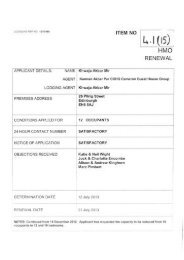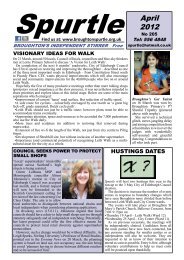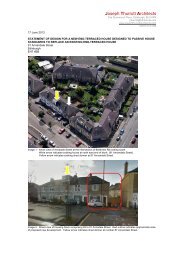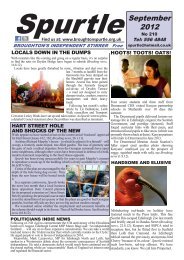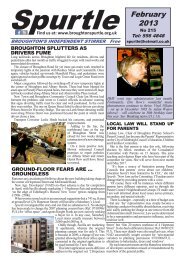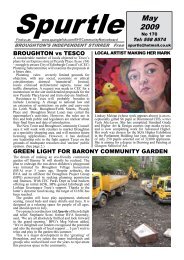BROUGHTON HISTORY SOCIETY NEWSLETTER - Broughton Spurtle
BROUGHTON HISTORY SOCIETY NEWSLETTER - Broughton Spurtle
BROUGHTON HISTORY SOCIETY NEWSLETTER - Broughton Spurtle
Create successful ePaper yourself
Turn your PDF publications into a flip-book with our unique Google optimized e-Paper software.
Meanwhile, he had married Mary Sim Hill in 1897.<br />
Their first house was at 25 Dalgety Street,<br />
Edinburgh where on 12th November 1898 the<br />
present writer’s mother Catherine Richardson<br />
Ritchie was born (her family name became Cassie).<br />
We next find the young Ritchies moving to 77<br />
McDonald Road; Catherine and her two younger<br />
sisters all started their education at <strong>Broughton</strong><br />
School a few hundred yards north of their home.<br />
She took after her father in character: shy, diffident,<br />
yet holding firmly to her carefully thought out<br />
beliefs. She was a bright scholar, particularly in<br />
essay writing. She had intended to be a school<br />
teacher but her voice was not strong enough<br />
for this profession so she became assistant<br />
secretary to the Queen’s Club in Frederick Street.<br />
In 1919 she met David Watt, newly home from the<br />
First World War. Their first meeting was in the social<br />
guild of the United Free Presbyterian Church in<br />
Portobello. It was seven years after they met before<br />
they were able to get married, on 10th July 1926. In<br />
those days married women did not work so she<br />
resigned on her marriage. They were chronically<br />
hard up – this was the period of the Great<br />
Depression. And soon they had the additional<br />
expense of their son, David Ritchie Watt, born on<br />
Friday 13th May 1927!<br />
Though the First World War took its toll on<br />
members of staff it was not until the depression of<br />
1930 and following staff dishonesty that the firm<br />
had to close the Princes Street branch. In the<br />
Second World War the younger staff members were<br />
called up and most of the skilled watch and clockmakers<br />
were lost to the new Ferranti factory. The<br />
firm were still pioneers – in the late 1940s when<br />
King George VI was being treated for vein trouble in<br />
his legs by Edinburgh University’s Professor<br />
Learmonth, the firm designed and made a machine<br />
to alleviate the trouble.<br />
In 1953 the sole remaining partner Leone Ritchie,<br />
then in his 80s, retired and the Leith Street<br />
premises were sold. The firm was taken over by his<br />
nephew, Robert<br />
Mitchell, and<br />
based in Little<br />
K i n g S t r e e t<br />
before settling<br />
in 56 <strong>Broughton</strong><br />
Street. After Mr<br />
Mitchell’s death<br />
the business<br />
left the family.<br />
It was bought<br />
by Mr Frank<br />
Pritchard, who<br />
had served his<br />
apprenticeship<br />
with the Ritchies.<br />
Under his leadership the business prospered, an<br />
associated firm of precision engineering being<br />
established in Livingston.<br />
James Ritchie & Son (Clockmakers) Ltd have two<br />
logos. One depicts Edinburgh Castle and Nelson’s<br />
Column with the time ball (previous page). The<br />
other has a picture of a young girl standing on a<br />
chair to alter the hands of a grandfather clock. This<br />
girl, Catherine Ritchie, was later to be my mother.<br />
Editor: The firm recently moved away from <strong>Broughton</strong><br />
Street and is now in Dundas Street – “James Ritchie &<br />
Son (Clockmakers) Ltd. Retail and Repairs”.<br />
Sources:<br />
Watt, David Ritchie (2001 )James Ritchie & Son<br />
(Clockmakers) Ltd., <strong>Broughton</strong> History Society<br />
Newsletter No.9.<br />
Watt, David R. (Spring 2000) The Family Tree of David<br />
R. Watt, compiled at 21 Bellevue Place.<br />
Correspondence between David Watt and John Dickie.<br />
THE <strong>HISTORY</strong> OF ROSSLYN CRESCENT<br />
Neighbouring Pilrig also has an interesting history. Celia and Sam Barron are researching a<br />
particular part of it<br />
A number of years ago we were curious to find out<br />
who had lived in our house in Rosslyn Crescent<br />
since it was built in 1886. As it turned out we didn’t<br />
find any really interesting past tenants but we did<br />
begin to see that the broader history of Rosslyn<br />
Crescent, and the adjacent Rosslyn Terrace, was<br />
much more fascinating. Thus began our project to<br />
research the history of the Crescent and the<br />
Terrace.<br />
The detective work became really addictive. Initially<br />
we looked at the deeds of our own house then<br />
widened our search area to look at the Register of<br />
Sasines, Post Office directories, the Valuation roll,<br />
newspapers, the Edinburgh Gazette and many<br />
other sources of information.<br />
Research is still at a very early stage and as yet we<br />
have no idea what the final outcome will be. The<br />
5<br />
following is just a taste of what we have<br />
discovered so far.<br />
THE LANDS OF THE LAIRD OF PILRIG<br />
The land on which Rosslyn Crescent and Rosslyn<br />
Terrace were built belonged to John Mackintosh<br />
Balfour, the 4th Laird of Pilrig, who lived in Pilrig<br />
House. It was at the extreme edge of Edinburgh<br />
with the boundary between Edinburgh and Leith<br />
running up the middle of Pilrig Street. Johnston’s<br />
1837 map (Figure 1 overleaf) shows an area of<br />
open green space dotted with large houses such<br />
as Bowers Hall, Pilrig House, Stewartfield,<br />
Rosebank, Powderhall, Blandfield and Shrub<br />
House. The population of Edinburgh quadrupled<br />
between 1801 and 1901 resulting in an urgent<br />
need for housing, so landowners began to feu<br />
parcels of land for house building. Barbara<br />
Balfour, in her book on the history of the Balfour



